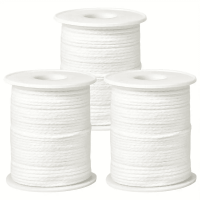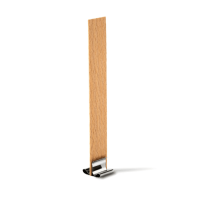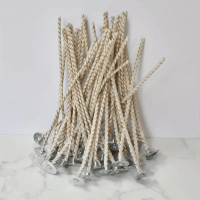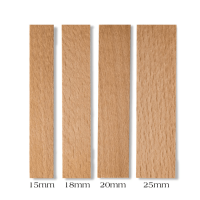Candle Wick
On 2025-02-02 17:44:48,Uncategorized
The Candle Wick
The question of which candle wick works best with which wax is often asked, especially as the number of types available is constantly increasing.
The wick is the soul of a candle, determining its burn time, flame size and evenness. Whether it is cotton, wood or waxed, choosing the right type and size is key. In our blog, we will introduce you to the types, sizes and tips for using wicks!
Choosing the right material and size is essential for candles to function properly. The uniformity of burning and the size of the flame are greatly influenced by the central part, which carries the molten material to the flame. The type and thickness of the material is adjusted to the size and type of candle, whether it is a scented candle, pillar candle or floating candle. It is important that the size is consistent with the diameter, so that burning problems such as burning too quickly or unevenly can be avoided. The optimal choice results in a longer burn time and a clearer light.
How it works:
The wick absorbs liquid wax or oil through capillary action.
When the wick is lit, the absorbed material burns, not the wick itself, which is why the burn lasts longer.
Some tips for choosing the perfect wick:
Wax test: Pour a candle with the desired wick and different sizes. Light the candle and watch it burn down. Make sure it burns evenly and doesn't smoke excessively or smolder. This will help you determine the right size.
Candle diameter: The diameter of the candle is important when choosing the right size and type. A wick that is too thin will create a tunnel, while a wick that is too thick can cause soot and smoke. Follow the manufacturer's recommendations or use the chart to determine the correct wick size for the diameter of the candle.
Wax type: Different types of wax have different properties and will require different wick sizes. For example, soy wax requires a larger wick than paraffin wax.
Sizes and Uses for Glass Candles
When choosing the right size, it is important to consider the diameter of the candle and the type of wax, as these affect the burning. General sizing recommendations:
Choosing the right wick for a candle depends on several factors, such as: the type of wax used, the diameter of the candle and the desired burn time.
Wick thickness - candle diameter:
Candle diameter Wick type and size
2–4 cm 3-4 mm
4–6 cm 5-6 mm
6–8 cm 7-8 mm
8+ cm Over 8 mm
Wooden wick
Wooden wick is an alternative wick type that provides a unique look and burning experience for candles. It is mostly used for natural, rustic or special decorative candles. Let's see what you should know about it!
What is a wooden wick? A wick is a thin strip of wood (rosewood, cherry, maple) used as a wick in candles. When burning, it makes a soft crackling, crackling sound, similar to the sound of a fire in a fireplace, creating a pleasant, cozy atmosphere.
Advantages:
Aesthetic appearance: Natural, modern and stylish
Mood: The crackling sound creates a sense of calm, especially on winter evenings. Especially good for meditation
Easy to use: Rigid, so it won't bend like a cotton wick
Long burn time: If you choose the right size for your candle, it will provide a long and even burn.Disadvantages:
Specific needs: It can be more difficult to achieve a perfect burn with certain waxes (e.g. soy wax)
Need to test: Choosing the right size and thickness is important because a wick that is too thin won't burn properly, and a wick that is too thick can create a too-big flame
Can be more expensive: Wooden wicks are generally more expensive than traditional cotton wicks, but it's definitely worth getting a quality wooden wick.
How to choose a wooden wick?
Size based on candle diameter:
Candle diameter Wick width
3–4 cm 0.5 cm wide, thin
5–6 cm 1 cm wide, medium
7–8 cm 1.5 cm wide or double
The image only provides informational dimensions. You may encounter several sizes depending on the brand.
Single-layer or double wick?
Single-layer: For small and medium-sized candles (e.g. glass candles).
Double wick: If the candle has a larger diameter (over 6 cm) or the wax is harder, it is worth placing two wicks on top of each other for better burning. (usually double wicking is what works, but test burning is also important here).
Tips for use
Use a wick holder: Special holders are available for wicks that hold the wick securely in the candle. Regardless, it is essential to secure the base to the glass, otherwise the base will slip out of place when the candle melts, causing the wax to flow into the burn or become one-sided.
Test the burn: Make sure the wick burns well and creates a proper melt pool.
Trim: Before lighting, trim the charred part of the wick so that it burns evenly the next time you light it.
Wax type: The wick works well with both paraffin and soy wax blends. You may need a thicker one than pure soy wax or beeswax.
Additional tips
Wax type: Soy wax may need a larger size because it burns slower. For paraffin candles, a smaller one will suffice.
Testing: It is always a good idea to make a test candle, especially if you are offering your product for sale. You need to check that your candle burns well and creates a proper melt path so that it doesn't soot.



